Ever heard about lactose-free milk? What exactly is it? You can miss out on some pretty serious nutrients if you are intolerant to lactose.
In short, lactose is a sugar which is found in almost all milk products. An enzyme called lactase should be present in the human body for the digestion of the sugar. In the small intestine, heavy sugars are split into simpler sugars and digested with the help of lactase. People who have a low amount of lactase in their body aren't able to digest the heavy sugar and thus are intolerant to lactose. When they consume this sugar, it reaches their large intestine in an unchanged form and thus it becomes difficult to digest it. Approximately 70% of the world's population suffers from lactose intolerance and it affects mostly adults.
Does this mean, that these people should completely stop consuming it? If people stop consuming such an important nutrition source, they would be unable to obtain all the important nutrients through a single source. This is where the milk for lactose intolerant come in. It is very beneficial for lactose intolerant people who can substitute their dairy products with products which contain low sugar contents. Let's take a look at five things you should know about the milk for lactose intolerant.
How is it prepared
For those who are intolerant to dairy sugars, consumption of dairy products can cause stomach cramps, vomiting, diarrhoea, headaches, etc. But this doesn't mean that they should just cut out the primary source of nutrition from their diet.
Reputed brands have come up with variants in milk to solve this problem- Milk for lactose intolerant. Unlike the name suggests, is not milk free from all lactose content. It is highly impossible to drain out all the complex sugars from dairy beverages. During the manufacturing, milk undergoes certain processes which split lactose in sugars like glucose and galactose. These are simple sugars and are easier to digest. No other nutrients other than the sugars content changes and thus enables people intolerant to dairy sugars to receive their daily dose of nutrients.
Extended shelf life:
The shelf life of this dairy product is longer than the regular milk. It is ultra pasteurised to elongate the shelf life. It undergoes a very high temperature for a short period of time which elongates the life of the product. As the demand for these types of milk variant is very less compared to the regular ones, the product is supposed to have a longer life.
Taste:
The dairy product is sweeter in taste as simple sugars taste sweet on your tongue. This is because of the complex sugars been broken down into two simple sugars- glucose and galactose. Simple sugars taste sweeter compared to the complex sugars. The taste is also slightly refined.
Nutritional benefits:
As we mentioned earlier, many people suffer from the intolerance of these sugars, lactose-free milk can help prevent the symptoms it causes. The older you get, the lesser is the lactase production in the body. Mostly, the countries which do not consume dairy products on a regular basis face these problems. Though it doesn't cause very serious illnesses, avoiding the consumption of products with dairy sugars is the only solution.
Generally, it is rare for babies to develop lactose intolerance. A baby's body generates lactase which helps in the digestion of complex sugars. In babies, lactose intolerance is more common in the ones who were prematurely born. Thus, there also is milk for babies which contains a low level of sugars. This helps the mothers around the world to give the right nutrients to their babies. Body decreases the generation of lactase as the child grows, hence, rather than milk with low lactose for babies, it can be opted for kids.
Non-dairy Alternatives:
There are many non-dairy alternatives, now, which does not contain cow's milk. They are prepared from soybeans, almonds, etc. These do not contain the exact nutrition which cow's milk provide but it is very beneficial for people suffering from lactose intolerance.
Consuming lactose-free milk is all the easier now because you do not have to walk down to stores looking for the products. In today's world, when you can order anything at just one click, buying lactose-free milk online is also pretty easy. You can buy it from various sites which provide you with groceries and products which are required in day to day life- like the dairy products. You can just find a trusted source and order dairy products online. There are many online dairies which provide you with this product.
Thus, to answer our initial question, you do not have to miss out on your daily nutrition dose if you are lactose intolerant. There is milk for lactose intolerant people. Milk contains essential nutrients and it is recommended that everyone should include it in their daily diet. These sugars are not only included in milk but also in all other dairy products like cheese, curd, yoghurt, etc. Just read the precautions on the packs before consuming the product. Eat right! Stay healthy!
Are you the Part of Population Who are Lactose intolerant, are you Missing out on milk as Important Part of Diet Because of low lactase in your body. It's time to relieve fret and time to be made aware that there are some Milk specially prepared for such lactose intolerant humans. Awesome Dairy helps you to reach out to your desired
Lactose-Free Milk with Variety of Brands Online, as well as on monthly subscription basis with delivery to your door step.
wana read free news check here
Wednesday, 30 August 2017
Friday, 12 May 2017
The most promising route to ‘mental superpowers’
When people are given a way to
see what’s happening inside their head in real-time, they can rapidly
learn how to dampen pain, enhance self-control and boost mental ability.
If more of us had access to this technique, it could be transformative.
Now imagine if you could see what was happening inside your brain as you experienced emotions and sensations such as pain, anxiety, depression, fear, and pleasure – all in real-time. Suddenly, why you feel the way you feel might not be such a mystery, and the effectiveness of the little mental techniques you use to deal with daily life would be clearly visible.
Through practice, you can learn to strengthen control over the mind similar to how a weightlifter targets a specific muscle groupThat’s the idea behind a new technique known as “real-time fMRI”. By receiving specific visual feedback about brain activity while executing mental tricks and strategies, we can learn to consciously control our emotions, sensations and cravings as if they were being manipulated by a volume knob on a stereo. Through practice, you can learn to strengthen control over the mind similar to how a weightlifter targets a specific muscle group – and it raises the tantalising possibility of a future where we can train advanced mental abilities far beyond our own today.
By focusing on controlling a virtual flame, people were able to reduce the pain they felt (Credit: iStock)
Importantly, decreases or increases in this neural signal correlated with subjective feelings of pain, as measured by a questionnaire and a 10-point pain scale. Amazingly, in just a single 13-minute session participants learned to easily control the size of the flame and were able to reduce their pain by over 50%.
Since then, research using real-time fMRI has exploded, and new clinical and experimental uses seem to pop just about every month. The ways of displaying brain activity to people also now includes feedback such as audio sounds or a ‘thermometer display’ via virtual reality goggles.
The training can create changes in the brain that have long-lasting effectsA 2017 study published in the journal Appetite showed that the training could fight obesity. Over the course of a four-day training period, overweight males learned to increase the interaction between the brain areas involved in executive functioning and reward processing, which improved self-control and led to healthier food choices.
Another study published this year found that by learning control over the right inferior prefrontal cortex, a brain region that is impaired in those with ADHD, adolescents could decrease ADHD symptoms and improve sustained attention. These benefits remained when the participants were tested 11 months later, demonstrating that the training can create changes in the brain that have long-lasting effects.
And a 2016 study found that elderly adults using the technique improved their cognition. It’s possible that younger individuals could boost brain function this way too. In fact, a 2015 study with healthy adults showed that neurofeedback training could improve focus and reduce lapses of attention.
Other recent studies have found that the training can be used to treat PTSD in war veterans, depression, anxiety, and even cigarette addiction. Another study by James Sulzer at the University of Texas, Austin and colleagues showed that participants could learn to regulate levels of the neurotransmitter dopamine, an application that could be used to treat Parkinson’s disease.
What would be the
ultimate potential of real-time fMRI training if one could practise
control over the brain every day? (Credit: Getty Images)
If a few 10-minute sessions can produce statistically significant results, what could 10,000 hours of practice do?And this opens up a whole new world of possibilities. To get a sense of the untapped potential, imagine what it would be like for an athlete or body builder to always be working out without ever getting a chance to see their body or the size of the weights. It would be impossibly hard to determine which exercises are working and which aren’t, and exactly to what degree. Effectively honing just about any skill requires visual feedback, and the same could be said for brain training.
What would be the ultimate potential of real-time fMRI training if one had easy access and could practise control over the brain weekly, or even daily, for many years? If a few 10-minute sessions can produce statistically significant results, what could 10,000 hours of practice do? There’s no true way to know, but something akin to “mental superpowers” may not be out of the question.
Neurofeedback training could provide a shortcut to the types of abilities displayed by monks, for example, who can completely block out excruciating pain and change their physiology to dry a soaking towel placed on their back in a chilly room.
So, while the ultimate potential of the technology remains to be seen, it is not unreasonable to believe that the awesome mind-over-matter abilities of expert meditators that take years to develop could one day be learned by everyone in a fraction of the time.
The countries where people still eat cats and dogs for dinner

Chinese vendors sell cooked dog meat at a market in Guiyang, southern China's Guizhou province in December 2016
Taiwan has banned the selling and eating of cats and dogs after a series of cruelty cases that caused widespread outrage.
The new Animal Protection Act will see anyone selling, eating or buying the animals for consumption facing fines of up to £6,500.
Those found guilty of animal cruelty could also receive a huge fine of £52,000 and two years in prison.
Taiwan is the first Asian country to crack down on the practice.
The new law tackles long-standing cultural beliefs about the benefits of eating dogs - for example, eating black dogs in winter is supposed to help you stay warm.
It was pushed through by President Tsai Ing-wen, who adopted three retired guide dogs last year and also has two cats, named Cookie and A-Tsai.
So what about the rest of the continent?
The practice of eating cats and dogs has become less common as pet ownership rises, and new generations have different attitudes to eating domestic animals.
But an estimated 30 million dogs across Asia, including stolen family pets, are still killed for human consumption every year, according to the Humane Society International.
While not widespread, the charity says the practice is most common in China, South Korea, The Philippines, Thailand, Laos, Vietnam, Cambodia and the region of Nagaland in India.
China

A customer holds a puppy for viewing at Yulin dog festival
Image caption A customer holds a puppy for viewing at Yulin dog festival
Although accurate figures are difficult to obtain, China is believed to be responsible for the majority of global cases of cat and dog slaughter.
Each year, around four million cats and 10 million dogs are believed to be slaughtered in the country. The Humane Society says the majority are stolen pets and strays that are captured and kept in cages.
The tradition of eating dogs dates back thousands of years, even though they are often kept as pets.
Each year in June, the city of Yulin in southern China hosts a dog meat festival, where live dogs and cats are sold specifically for eating and an estimated 10,000 are slaughtered for their meat.
South Korea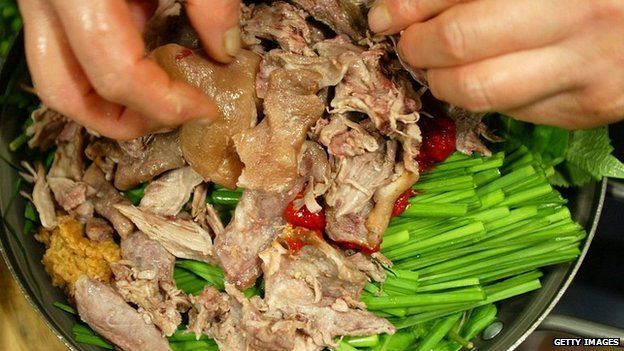
Dog meat has long been a familiar ingredient in meals in countries like China and South Korea
Image caption Dog meat has long been a familiar ingredient in meals in countries like China and South Korea
In South Korea, dog meat dishes are so common that they have their own name - Gaegogi.
The country has an estimated 17,000 dog farms, according to the Humane Society, where animals are routinely prepared for human consumption.
However, similar to other countries, pressure from welfare groups is having an impact.
MORE STORIES:
In February, the biggest dog meat market in Seongnam was closed down as part of a wider crackdown ahead of the country's hosting of the Winter Olympics next year.
Vietnam

Dogs in Thailand, destined for Vietnam
Image caption Dogs in Thailand, destined for Vietnam
Around five million dogs are believed to be slaughtered for eating in the country each year.
And the demand has led to an illegal trade from neighbouring countries, including Thailand, Cambodia and Laos.
The Asia Canine Protection Alliance (Acpa), which lobbies governments to try to end the dog meat trade, says there is some evidence that the dog meat trade is dangerous to humans, leading to an increase in diseases like rabies.
Acpa's focus is to end the illegal trade of dogs from Thailand and Laos into Vietnam, where an estimated five million dogs are slaughtered every year for human consumption, by tackling both the supply of dogs from Thailand and Laos, and the demand for dogs for consumption in Vietnam.

Chinese vendors sell cooked dog meat at a market in Guiyang, southern China's Guizhou province in December 2016
Taiwan has banned the selling and eating of cats and dogs after a series of cruelty cases that caused widespread outrage.
The new Animal Protection Act will see anyone selling, eating or buying the animals for consumption facing fines of up to £6,500.
Those found guilty of animal cruelty could also receive a huge fine of £52,000 and two years in prison.
Taiwan is the first Asian country to crack down on the practice.
The new law tackles long-standing cultural beliefs about the benefits of eating dogs - for example, eating black dogs in winter is supposed to help you stay warm.
It was pushed through by President Tsai Ing-wen, who adopted three retired guide dogs last year and also has two cats, named Cookie and A-Tsai.
So what about the rest of the continent?
The practice of eating cats and dogs has become less common as pet ownership rises, and new generations have different attitudes to eating domestic animals.
But an estimated 30 million dogs across Asia, including stolen family pets, are still killed for human consumption every year, according to the Humane Society International.
While not widespread, the charity says the practice is most common in China, South Korea, The Philippines, Thailand, Laos, Vietnam, Cambodia and the region of Nagaland in India.
China

A customer holds a puppy for viewing at Yulin dog festival
Image caption A customer holds a puppy for viewing at Yulin dog festival
Although accurate figures are difficult to obtain, China is believed to be responsible for the majority of global cases of cat and dog slaughter.
Each year, around four million cats and 10 million dogs are believed to be slaughtered in the country. The Humane Society says the majority are stolen pets and strays that are captured and kept in cages.
The tradition of eating dogs dates back thousands of years, even though they are often kept as pets.
Each year in June, the city of Yulin in southern China hosts a dog meat festival, where live dogs and cats are sold specifically for eating and an estimated 10,000 are slaughtered for their meat.
- READ MORE
This girls' football team just topped a league for boys in Spain
This inspirational lady overcame cancer to graduate from university with distinction
Tips to last longer during sex
South Korea

Dog meat has long been a familiar ingredient in meals in countries like China and South Korea
Image caption Dog meat has long been a familiar ingredient in meals in countries like China and South Korea
In South Korea, dog meat dishes are so common that they have their own name - Gaegogi.
The country has an estimated 17,000 dog farms, according to the Humane Society, where animals are routinely prepared for human consumption.
However, similar to other countries, pressure from welfare groups is having an impact.
MORE STORIES:
In February, the biggest dog meat market in Seongnam was closed down as part of a wider crackdown ahead of the country's hosting of the Winter Olympics next year.
Vietnam

Dogs in Thailand, destined for Vietnam
Image caption Dogs in Thailand, destined for Vietnam
Around five million dogs are believed to be slaughtered for eating in the country each year.
And the demand has led to an illegal trade from neighbouring countries, including Thailand, Cambodia and Laos.
The Asia Canine Protection Alliance (Acpa), which lobbies governments to try to end the dog meat trade, says there is some evidence that the dog meat trade is dangerous to humans, leading to an increase in diseases like rabies.
Acpa's focus is to end the illegal trade of dogs from Thailand and Laos into Vietnam, where an estimated five million dogs are slaughtered every year for human consumption, by tackling both the supply of dogs from Thailand and Laos, and the demand for dogs for consumption in Vietnam.
Flyship – The Future Of Travel Both On Air And Water
Fly-ship – The Future Of Travel Both On Air And Water
A new hybrid of boat and plane called “The FlyShip” is an £26m ($37m)
vehicle that can carry 100 passengers at a top speed of
155mph(250km/h). The flyship hovers by creating a cushion of air under
its wings. It can be used for various missions like cargo, commercial,
military and anti-piracy transport.

Designed by German engineering team will surely revolutionize the way people travel. The flyship has a cabin space area of 1500 sq.ft, 121ft (37 metres) long and has a wingspan of 131ft (40 metres). On a hovercraft, it is supported by a huge fan in the middle. When compared to other flying planes, it is cheaper and the fuel consumption is also low with 270 litres every hour when compared to 3300 litres every hour in other let liners.
MORE STOTIES:



Designed by German engineering team will surely revolutionize the way people travel. The flyship has a cabin space area of 1500 sq.ft, 121ft (37 metres) long and has a wingspan of 131ft (40 metres). On a hovercraft, it is supported by a huge fan in the middle. When compared to other flying planes, it is cheaper and the fuel consumption is also low with 270 litres every hour when compared to 3300 litres every hour in other let liners.
MORE STOTIES:
Seven brothers and sisters adopted by same couple after four years in care
Top 10 Cancer Causing Foods to Cut Your Cancer Risk in Half
10 Dangerous Reasons You Should Never Eat Junk Foods Again…No 9 Will Shake You


Seven brothers and sisters adopted by same couple after four years in care
Seven brothers and sisters adopted by same couple after four years in care

Clark family
Seven brothers and sisters who spent nearly four years in care have been adopted by the same couple.
Maria, Elizabet, Guillermo, Jason, Kristina, Katerin and James have been adopted by Josh and Jessaka Clark in Georgia, US.
The siblings were in care for 1,359 days before the couple's adoption process was completed on 9 May 2017.
Josh and Jessaka started the process two years ago and the children lived with the couple for the past 10 months.
The couple already had one biological son, Noah, and refer to the new additions as their "super seven".
Jessaka has posted photos of the happy family on her Facebook page and shared several updates on their progress.
Clark family
Image caption Jessaka shared this photo on Facebook when the family's adoption process was completed
"My husband Josh and I both knew that we wanted to adopt children. We had decided this before we even met each other," Jessaka told Fox News.
"Josh has a heart for the thousands of children that don't have parents and knew he wanted to bring some of them into his home."
That home looks likely to get even bigger after the couple raised more than $20,000 (£15,500) on Go Fund Me in less than 24 hours to expand their property to make more rooms for the family.
Their fundraising page also states that the couple plan to take in more children.

Jessaka Clark
Image caption "Going to the school right now to change my babies name," Jessaka wrote on Facebook
Jessaka says she was inspired to adopt children by her parents and she has two adopted brothers of her own.
After the Clark's story was covered in US media, Jessaka says she hopes they would inspire others.
"We are truly blessed to be able to show people the beauty in adoption and shed light on the need for foster and adoptive parents," she wrote on her Facebook page.
She also shared photos from a school visit on 10 May to change the children's names.

Clark family
Seven brothers and sisters who spent nearly four years in care have been adopted by the same couple.
Maria, Elizabet, Guillermo, Jason, Kristina, Katerin and James have been adopted by Josh and Jessaka Clark in Georgia, US.
The siblings were in care for 1,359 days before the couple's adoption process was completed on 9 May 2017.
Josh and Jessaka started the process two years ago and the children lived with the couple for the past 10 months.
The couple already had one biological son, Noah, and refer to the new additions as their "super seven".
Jessaka has posted photos of the happy family on her Facebook page and shared several updates on their progress.

Clark family
Image caption Jessaka shared this photo on Facebook when the family's adoption process was completed
"My husband Josh and I both knew that we wanted to adopt children. We had decided this before we even met each other," Jessaka told Fox News.
"Josh has a heart for the thousands of children that don't have parents and knew he wanted to bring some of them into his home."
That home looks likely to get even bigger after the couple raised more than $20,000 (£15,500) on Go Fund Me in less than 24 hours to expand their property to make more rooms for the family.
MORE STORIES:
Huge otter fossil, millions of years old, discovered in China
Top 10 Cancer Causing Foods to Cut Your Cancer Risk in Half
Prince William's 'touching' letter when my navy dad died
Their fundraising page also states that the couple plan to take in more children.

Jessaka Clark
Image caption "Going to the school right now to change my babies name," Jessaka wrote on Facebook
Jessaka says she was inspired to adopt children by her parents and she has two adopted brothers of her own.
After the Clark's story was covered in US media, Jessaka says she hopes they would inspire others.
"We are truly blessed to be able to show people the beauty in adoption and shed light on the need for foster and adoptive parents," she wrote on her Facebook page.
She also shared photos from a school visit on 10 May to change the children's names.
10 Dangerous Reasons You Should Never Eat Junk Foods Again…No 9 Will Shake You

Eating of junk foods comes at a very high health cost as they end up being detrimental to the proper functioning of the human body.
There is nothing as good as well cooked home made foods and fruits. Fruits are very essential to the body. Junk foods are easily accessible, some of them are even cheap but the number of harm they do to the body is infinite.
Most junk are enriched in sugar which probably make you want to eat more but before you buy the next one, read this very well.
(1) Risk of cancer
Lack of fibre is the main reason why junk food consumption is linked to an increased risk of cancers of the digestive system. A study published in European Journal of Cancer Prevention revealed that consuming too much of fast food that are high in sugar and fat can increase your chances of developing colorectal cancer. Another study from the Fred Hutchinson Cancer Research Center, Seattle showed that men who ate fried foods more than twice in a month had increased risk of developing prostate cancer.
(2) Risk of type 2 diabetes
One of major contributing factors for the emerging diabetes epidemic is unhealthy diet full of junk and fast food. When you eat a healthy diet, your body gets a steady supply of glucose, which helps maintain insulin sensitivity. On the other hand, when you eat only junk food, the excessive stress exerted on your metabolism affects the ability of your body to use insulin properly. Since junk food lacks fibre content, its consumption directly results in a spike in sugar levels. Further, junk food consumption leads to obesity, one of the main reasons for insulin resistance and development of diabetes.
(3) Risk of digestive problems
Those who are addicted to fatty junk food are bound to suffer from digestive problems like gastroesophageal reflux disease (GERD) and irritable bowel syndrome (IBS). That’s because junk food is deep fried. The oil soaked in junk food gets deposited on the walls of the stomach lining, increases acid production. Spices loaded in them irritate the stomach lining, worsening GERD and digestion. Lack of fibre in them hampers digestion, increasing problems like constipation and haemorrhoids. Try this yoga pose to improve digestion.
(4) Risk of kidney disease
The reason why you can never say no to fries and chips is because they contain high amount of finely processed salt which increases salivation and secretion of enzymes that enhance your cravings for these foods. High amount of bad fats and sodium from salt disrupts the sodium-potassium balance of the body and causes hypertension. Since the kidney have to filter all the toxins from the blood, eating a lot of junk food has a direct effect on the kidney functioning.
(5) Risk of heart disease
Junk food items are loaded with saturated fats and trans fats that directly increase triglyceride and bad cholesterol (LDL) levels in the blood, contributing to plaque formation and heart disease. Further, causing a sudden spike in blood sugar level increases, junk food damages the linings of the blood vessels causing chronic inflammation.
This inflammation causes bad cholesterol to stick to the walls of the arteries, blocking blood flow to the heart. When they’re blocked enough, heart attack occurs. Fats from junk food can accumulate over a period of time in your body to make you obese. The more weight you put on, the higher your risk of suffering from heart attack. Refer to these heart healthy diet tips for people with heart diseases.
6) Causes fatigue and weakness
Junk food lacks most of essential nutrients like proteins and vitamins required for maintenance of overall health and functioning of all the systems in your body. Although it makes you feel full and satisfied, it fails to provide you with instant energy, making you feel weak and tired after a while. If you eat junk food items for all your meals of the day over a period of time, you could be suffer from chronic fatigue. Junk food can lower your energy levels to an extent that it may become difficult for you to even perform your daily tasks.
(7) Causes depression among teenagers
A lot of hormonal changes occur in teenagers, which makes them susceptible to mood swings and behavioural changes. And a healthy diet plays an important role in maintaining that hormonal balance. Because junk food lack those essential nutrients, the likelihood of teenagers to suffer from depression is increased by 58 percent. Here are some facts you need to know about depression.
(8) Causes fluctuations in blood sugar levels
Junk food is high in refined sugar which exerts stress on your metabolism. Refined sugar causes the pancreas to secrete more amount of insulin in order to prevent a drastic spike in your blood sugar levels. Because junk food lacks sufficient levels of good carbohydrates and proteins, the levels of blood sugar drop suddenly after you eat. This makes you feel irritable and further increases you craving for more junk food.
(9) Affects the Brain
A study published in the journal Brain, Behavior, and Immunity shows that one week of eating junk food is enough to trigger memory impairment in rats. Recent research suggests that bad fats (trans fats) from junk food tends to replace healthy fats in the brain and interferes with its normal signalling mechanism. Studies in animals have also shown that fats from junk food slow down the ability to learn new skills. Try these home remedies to boost your brain power.
(10) Spoils your liver
Surprisingly, junk food consumption over a period of time can have similar harmful effect on the liver as alcohol consumptions does. A study reported that people who ate junk food and shunned exercise showed changes in liver enzymes within four weeks. These changes were similar to those observed in people with alcohol abuse.
According to some studies, it’s the high level of trans fats found in a number of junk food which cause liver dysfunction due to deposition in the liver.
Don’t Miss The Stuff You Love!
Subscribe to our mailing list and get interesting stuff and updates to your email inbox.
MORE STORIES
8 Electric Vehicles That Are Hitting The Road By 2020
8 Electric Vehicles That Are Hitting The Road By 2020
With developments in clean tech, we are only a few years away from
the widespread introduction of electric vehicles. But it won’t be long
before there’s an influx of long-range electric cars hitting the market.
Major automakers, including General Motors and Volkswagen, have vowed to roll out more than one fully electric car by 2020. Here’s a look at some of the vehicles hitting the roads in the next few years.
Faraday Future

Faraday Future says it will have a car on the road within the next four years. The mysterious car startup Faraday Future is promising it will have a car on the road sometime during the next few years. Faraday told Tech Insider at CES that it’s working on having its first production car on the roads in the next few years.
Major automakers, including General Motors and Volkswagen, have vowed to roll out more than one fully electric car by 2020. Here’s a look at some of the vehicles hitting the roads in the next few years.
Faraday Future

Faraday Future says it will have a car on the road within the next four years. The mysterious car startup Faraday Future is promising it will have a car on the road sometime during the next few years. Faraday told Tech Insider at CES that it’s working on having its first production car on the roads in the next few years.
MORE STORIES
Metallica are 'up for playing in space' and say they have 'a few feelers out'
Metallica are 'up for playing in space' and say they have 'a few feelers out'

Lars Ulrich from Metallica
Metallica say they're up for becoming the first band to play in space.
The band's drummer, Lars Ulrich, says the thrash group "has a few feelers out" to see if it would be possible in the next few years.
Speaking to Sirius XM, the 53-year-old said: "Living in San Francisco which is the gateway to the future, obviously all those things are being planned around San Francisco - to a degree.
"So I feel that we are close to that as we can be."
The band set a new Guinness World Record in 2013 after playing on all seven continents in a year.
They finished that stunt off by performing inside a dome on Argentina's Carlini base in the Antarctic.

Kirk Hammett and James Hetfield from Metallica
Lars Ulrich says they haven't thought about the idea too much, but would definitely enjoy playing in zero gravity.
"I don't really want to commit to anything other than to say that if there really is a possibility for this to happen, then we will happily be at the very front of that line.
"I think we've shown over the last few decades that sense of spirit, that sense of adventure, still burns in us and that we would love to.
"[We] would bend over backwards to make anything out of the ordinary happen - so watch this space."

James Hetfield from Metallica
Metallica started the North America leg of their WorldWired tour in Baltimore on Wednesday.
Robert Trujillo
They travel to the UK in October for dates in London, Glasgow, Manchester and Birmingham.
Meanwhile, bassist Robert Trujillo's son has finished his stint playing with Korn.
Tye, who's 12, stood in for regular bass player Reginald Arvizu on seven dates in South America.

Tye Trujillo and Jonathan Davis
Dad Robert joined him and the rest of the band on stage in Lima, Peru, for a jam and a headbang.
Reginald Arvizu, or Fieldy as he's known in Korn, re-joined the group for their performance at Carolina Rebellion earlier this month.

Lars Ulrich from Metallica
Metallica say they're up for becoming the first band to play in space.
The band's drummer, Lars Ulrich, says the thrash group "has a few feelers out" to see if it would be possible in the next few years.
Speaking to Sirius XM, the 53-year-old said: "Living in San Francisco which is the gateway to the future, obviously all those things are being planned around San Francisco - to a degree.
"So I feel that we are close to that as we can be."
The band set a new Guinness World Record in 2013 after playing on all seven continents in a year.
They finished that stunt off by performing inside a dome on Argentina's Carlini base in the Antarctic.

Kirk Hammett and James Hetfield from Metallica
Lars Ulrich says they haven't thought about the idea too much, but would definitely enjoy playing in zero gravity.
"I don't really want to commit to anything other than to say that if there really is a possibility for this to happen, then we will happily be at the very front of that line.
"I think we've shown over the last few decades that sense of spirit, that sense of adventure, still burns in us and that we would love to.
MORE STORIES:
"[We] would bend over backwards to make anything out of the ordinary happen - so watch this space."

James Hetfield from Metallica
Metallica started the North America leg of their WorldWired tour in Baltimore on Wednesday.
Robert Trujillo
They travel to the UK in October for dates in London, Glasgow, Manchester and Birmingham.
Meanwhile, bassist Robert Trujillo's son has finished his stint playing with Korn.
Tye, who's 12, stood in for regular bass player Reginald Arvizu on seven dates in South America.

Tye Trujillo and Jonathan Davis
Dad Robert joined him and the rest of the band on stage in Lima, Peru, for a jam and a headbang.
Reginald Arvizu, or Fieldy as he's known in Korn, re-joined the group for their performance at Carolina Rebellion earlier this month.
The pets causing their famous owners problems - think Johnny Depp's Boo and Pistol
The pets causing their famous owners problems - think Johnny Depp's Boo and Pistol
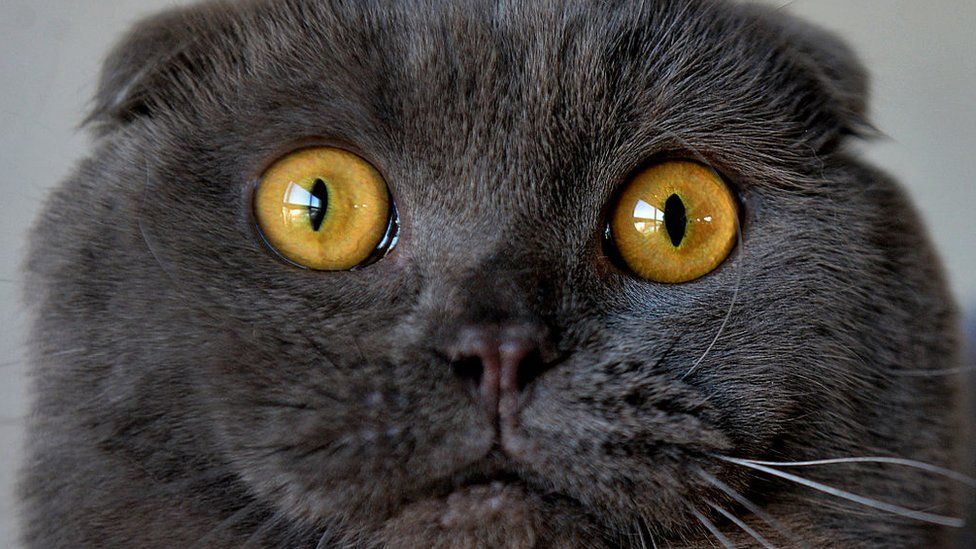
Scottish fold cat
A breed of cat with genetic health issues is hugely popular as a result of celebrity owners like Taylor Swift.
Taylor posts photos on Instagram of her Scottish fold cats Olivia Benson and Meredith Grey, which are famous for their small floppy ears.
Their features make them cute but the British Veterinary Association has warned that breeding should stop over health fears.
But what other celebrity pets are causing controversy for their owners?
Meredith has been mad all day.
A post shared by Taylor Swift (@taylorswift) on Jun 9, 2015 at 4:33pm PDT
Johnny Depp
The actor's dogs caused major drama with the Australian government while Johnny was filming in Australia.
Enable it in your browser or download Flash Player here.
Sorry, you need Flash to play this.
Video caption Johnny Depp and his wife Amber Heard expressed remorse in a video message made public by the Australian Department of Agriculture
His ex-wife Amber Heard was accused of not declaring Yorkshire Terriers Boo and Pistol to customs officials when they flew into Queensland.
Amber Heard pleaded guilty to falsifying an immigration document. The more serious charges of illegally importing animals were dropped.
Tyga
The rapper known for dating Kylie Jenner nearly faced jail time for illegal possession of a tiger.
After months of showing the big cat off on Instagram, authorities found out and took him away.
According to TMZ, the tiger is now living in a rescue centre, but staff say Tyga's "never made any effort to help out with his care".
They say it costs more than over £7,700 a year to feed him, along with vet costs, flea control and general maintenance.
Ariana Grande
Ariana's dogs, Toulouse and Sirius, were subject to an international argument between the pop star's mother and a ferry company.
The dogs weren't allowed to make the crossing from Calais to Dover because their documents weren't valid.
Later, Ariana tweeted that what had happened was "unacceptable" and asked for people and animals to be treated with respect.
Justin Bieber
The Canadian pop star and his former pet monkey caused all sorts of chaos back in 2013.
MORE STORIES
Justin Bieber illegally bought Mally on the black market, travelled the world with him and ignored government fines and demands for proof of legal purchase.
FOLLOW on twiter

Justin Bieber and his monkey Mally
He was then accused of animal abuse against the six-month-old Capuchin, with allegations of mistreatment and abandonment.
The singer was in Germany during his tour when his pet was seized by customs and taken to an animal shelter in Munich.
Robert Pattinson
The Twilight star had an ugly custody battle after breaking up with co-star Kristen Stewart, for their dog named Bear.
According to Hollywood Life, the couple shared Bear while they were dating, but after they split Kristen reportedly took legal action to get full custody.
Robert Pattinson won the case, and moved out of his ex's house with the mixed breed rescue adopted from a shelter in New Orleans.

Scottish fold cat
A breed of cat with genetic health issues is hugely popular as a result of celebrity owners like Taylor Swift.
Taylor posts photos on Instagram of her Scottish fold cats Olivia Benson and Meredith Grey, which are famous for their small floppy ears.
Their features make them cute but the British Veterinary Association has warned that breeding should stop over health fears.
But what other celebrity pets are causing controversy for their owners?
Meredith has been mad all day.
A post shared by Taylor Swift (@taylorswift) on Jun 9, 2015 at 4:33pm PDT
Johnny Depp
The actor's dogs caused major drama with the Australian government while Johnny was filming in Australia.
Enable it in your browser or download Flash Player here.
Sorry, you need Flash to play this.
Video caption Johnny Depp and his wife Amber Heard expressed remorse in a video message made public by the Australian Department of Agriculture
His ex-wife Amber Heard was accused of not declaring Yorkshire Terriers Boo and Pistol to customs officials when they flew into Queensland.
Amber Heard pleaded guilty to falsifying an immigration document. The more serious charges of illegally importing animals were dropped.
Tyga
The rapper known for dating Kylie Jenner nearly faced jail time for illegal possession of a tiger.
After months of showing the big cat off on Instagram, authorities found out and took him away.
According to TMZ, the tiger is now living in a rescue centre, but staff say Tyga's "never made any effort to help out with his care".
They say it costs more than over £7,700 a year to feed him, along with vet costs, flea control and general maintenance.
Ariana Grande
Ariana's dogs, Toulouse and Sirius, were subject to an international argument between the pop star's mother and a ferry company.
The dogs weren't allowed to make the crossing from Calais to Dover because their documents weren't valid.
Later, Ariana tweeted that what had happened was "unacceptable" and asked for people and animals to be treated with respect.
Justin Bieber
The Canadian pop star and his former pet monkey caused all sorts of chaos back in 2013.
MORE STORIES
Checkatrade Trophy: Under-21 teams to remain in revised competition
Huge otter fossil, millions of years old, discovered in China
What is it about Glastonbury's location which makes it so muddy?
Justin Bieber illegally bought Mally on the black market, travelled the world with him and ignored government fines and demands for proof of legal purchase.
FOLLOW on twiter

Justin Bieber and his monkey Mally
He was then accused of animal abuse against the six-month-old Capuchin, with allegations of mistreatment and abandonment.
The singer was in Germany during his tour when his pet was seized by customs and taken to an animal shelter in Munich.
Robert Pattinson
The Twilight star had an ugly custody battle after breaking up with co-star Kristen Stewart, for their dog named Bear.
According to Hollywood Life, the couple shared Bear while they were dating, but after they split Kristen reportedly took legal action to get full custody.
Robert Pattinson won the case, and moved out of his ex's house with the mixed breed rescue adopted from a shelter in New Orleans.
Checkatrade Trophy: Under-21 teams to remain in revised competition
Checkatrade Trophy: Under-21 teams to remain in revised competition

Coventry
Coventry City defeated Oxford United at Wembley in the 2017 EFL Trophy final
League One and Two clubs have voted to retain invited under-21 teams in the Checkatrade Trophy for two more seasons, along with a increase in prize money and changes to selection rules.
In a one-season trial, 16 Premier League and Championship under-21 sides were added to the 2016-17 tournament.
Clubs voted on three options: keeping academy teams, reverting to the old 48-team format or ending the competition.
Coventry City won this season's EFL Trophy in front of nearly 75,000 spectators at Wembley in April, although the early rounds of the competition were greeted by fan boycotts and low attendances.
Luton manager Nathan Jones, who was critical of this season's team selection criteria, has said he is "pleased our feedback has been taken on board".
Jones continued: "Just as importantly though, the EFL have assured clubs that it isn't the thin end of the wedge in terms of Premier League clubs being able to enter B teams into the league.
"I know our supporter groups have been consulted all the way through by the club's board when giving our views, and hopefully any fears they had on that front have been allayed."
A key reason behind the change was to give young players a chance to play competitive fixtures and 27% of players who started EFL Trophy matches in 2016-17 were English under-21s, up from 23% in 2015-16, and 18% in 2014-15.
What are the changes?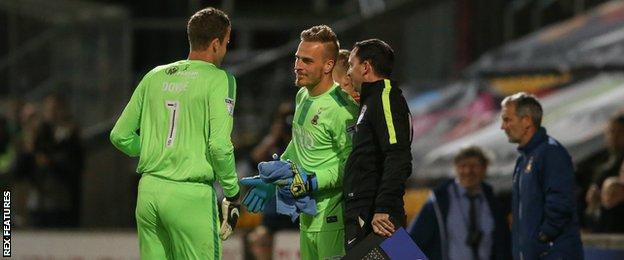
Colin Doyle & Rouven Sattelmaier
Bradford replaced goalkeeper Colin Doyle with Rouven Sattelmaier three minutes into their EFL Trophy win over Bury
Some League One and Two clubs were fined this season for fielding "weakened teams", but changes have been made to allow for greater selection flexibility for clubs.
Third-tier and fourth-tier clubs are now able to choose any goalkeeper and only four starting outfield players now have to be "qualifying first-team players", while invited sides need to have six under-21 players in their starting line-up.
Furthermore, the prize money for the competition has increased from just under £2m to £3m - the bulk of which comes from the Premier League - and regionalisation of the competition will remain until the quarter-final stages.
Invited teams will also play all of their group matches away from home - avoiding scenes such as 274 fans attending The Hawthorns to watch West Bromwich Albion's Under-21 side take on League One Gillingham.
There has been no guarantee from the Premier League clubs who refused to participate this season - including Arsenal, Tottenham, Manchester United, Manchester City and Liverpool - that they will be involved next season.
However, the English Football League hope the flexibility of being able to schedule matches outside international windows will make the proposition more attractive.
'Revised format benefits all parties'

Coventry City
Coventry were not alone in getting small crowds for the early rounds, but took in excess of 43,000 fans to the final at Wembley
EFL chief executive Shaun Harvey: "We wanted to ensure that League One and League Two clubs had the opportunity to make the key decisions regarding where we take the competition in 2017-18 and beyond, and I believe we have reached a revised format that benefits all parties.
"EFL clubs will have greater flexibility with regard to team selection, while still maintaining the principle that this is a first-team competition for our clubs that will support the development and progression of young players.
"The competition will also provide significant financial rewards for all EFL clubs, which increases with success."
Analysis
Simon Stone, BBC Sport
There is no doubt the additional £1m prize money has played a big part in this competition continuing.
Derided by fans - and some clubs, the tournament has been saved by the Premier League offering additional funds, proving, in a week when Accrington have questioned their involvement in the lower league, just how important their financial input actually is.
However, whilst the concept of providing a competitive platform for England's best young players is one for which the EFL should be applauded, the best has to mean the best.
Arsenal, Manchester City, Manchester United, Tottenham and Liverpool opted not to take part last season.
For there to be any point to the Checkatrade Trophy in its revised form, they need to be involved next term.

Coventry
Coventry City defeated Oxford United at Wembley in the 2017 EFL Trophy final
League One and Two clubs have voted to retain invited under-21 teams in the Checkatrade Trophy for two more seasons, along with a increase in prize money and changes to selection rules.
In a one-season trial, 16 Premier League and Championship under-21 sides were added to the 2016-17 tournament.
Clubs voted on three options: keeping academy teams, reverting to the old 48-team format or ending the competition.
MORE STORIES
Huge otter fossil, millions of years old, discovered in China
'Why I stick pro-vegan stickers on meat in supermarkets'
What is it about Glastonbury's location which makes it so muddy?
Two-thirds of clubs lent their support to the 64-team format.Coventry City won this season's EFL Trophy in front of nearly 75,000 spectators at Wembley in April, although the early rounds of the competition were greeted by fan boycotts and low attendances.
Luton manager Nathan Jones, who was critical of this season's team selection criteria, has said he is "pleased our feedback has been taken on board".
Jones continued: "Just as importantly though, the EFL have assured clubs that it isn't the thin end of the wedge in terms of Premier League clubs being able to enter B teams into the league.
"I know our supporter groups have been consulted all the way through by the club's board when giving our views, and hopefully any fears they had on that front have been allayed."
A key reason behind the change was to give young players a chance to play competitive fixtures and 27% of players who started EFL Trophy matches in 2016-17 were English under-21s, up from 23% in 2015-16, and 18% in 2014-15.
What are the changes?

Colin Doyle & Rouven Sattelmaier
Bradford replaced goalkeeper Colin Doyle with Rouven Sattelmaier three minutes into their EFL Trophy win over Bury
Some League One and Two clubs were fined this season for fielding "weakened teams", but changes have been made to allow for greater selection flexibility for clubs.
Third-tier and fourth-tier clubs are now able to choose any goalkeeper and only four starting outfield players now have to be "qualifying first-team players", while invited sides need to have six under-21 players in their starting line-up.
Furthermore, the prize money for the competition has increased from just under £2m to £3m - the bulk of which comes from the Premier League - and regionalisation of the competition will remain until the quarter-final stages.
Invited teams will also play all of their group matches away from home - avoiding scenes such as 274 fans attending The Hawthorns to watch West Bromwich Albion's Under-21 side take on League One Gillingham.
There has been no guarantee from the Premier League clubs who refused to participate this season - including Arsenal, Tottenham, Manchester United, Manchester City and Liverpool - that they will be involved next season.
However, the English Football League hope the flexibility of being able to schedule matches outside international windows will make the proposition more attractive.
'Revised format benefits all parties'

Coventry City
Coventry were not alone in getting small crowds for the early rounds, but took in excess of 43,000 fans to the final at Wembley
EFL chief executive Shaun Harvey: "We wanted to ensure that League One and League Two clubs had the opportunity to make the key decisions regarding where we take the competition in 2017-18 and beyond, and I believe we have reached a revised format that benefits all parties.
"EFL clubs will have greater flexibility with regard to team selection, while still maintaining the principle that this is a first-team competition for our clubs that will support the development and progression of young players.
"The competition will also provide significant financial rewards for all EFL clubs, which increases with success."
Analysis
Simon Stone, BBC Sport
There is no doubt the additional £1m prize money has played a big part in this competition continuing.
Derided by fans - and some clubs, the tournament has been saved by the Premier League offering additional funds, proving, in a week when Accrington have questioned their involvement in the lower league, just how important their financial input actually is.
However, whilst the concept of providing a competitive platform for England's best young players is one for which the EFL should be applauded, the best has to mean the best.
Arsenal, Manchester City, Manchester United, Tottenham and Liverpool opted not to take part last season.
For there to be any point to the Checkatrade Trophy in its revised form, they need to be involved next term.
'Why I stick pro-vegan stickers on meat in supermarkets'
'Why I stick pro-vegan stickers on meat in supermarkets'
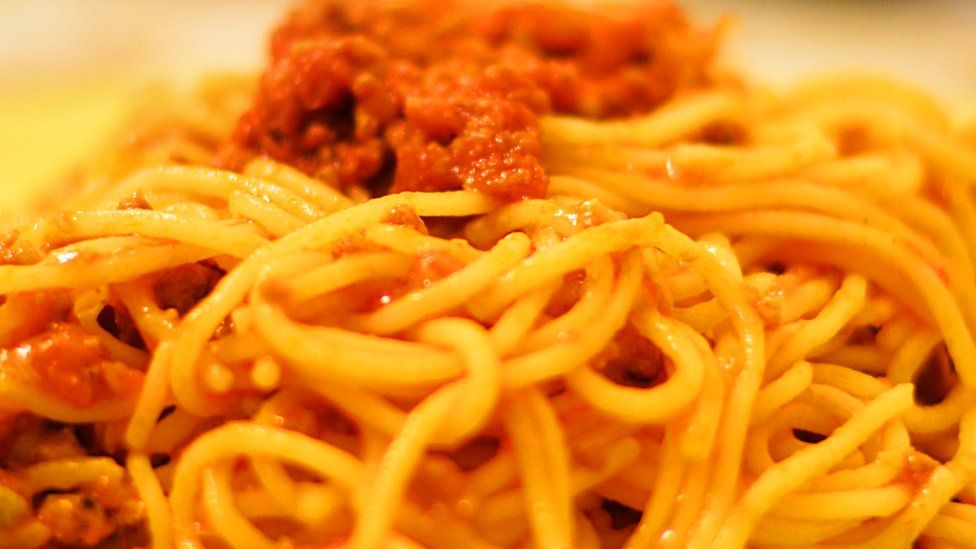
spag bol on a plate
A customer says she was shocked and felt "emotionally blackmailed" after finding an anti-meat sticker on a packet of spaghetti bolognaise.
Leah Mallett bought the ready meal at a Morrisons supermarket in Leeds.
Marc Gurney, who runs a vegan campaign in Brighton, says he wants people to think about what they're eating.
"I think it's important that people understand that it's not right for an animal to be killed when there are so many alternatives to animal products."
He's told Newsbeat that it's also important people think about what animals go through in the food industry.
"If this girl was horrified and scared then perhaps she needs to think twice about what she puts on her plate," he says.
"She needs to consider what the cow was going through while it was experiencing a brutal torture."
cow in field
Image caption This is not the cow used on the stickers, the bovine on the campaign looks far more distressed
It's understood that the case in Leeds isn't a one-off and is part of a wider campaign.
The note that got people talking shows a cow which looked distressed along with the words: "My name was Chloe. I wanted to live. Your 'personal choice' killed me. DON'T BUY IT."
The news has been shared by Vegan Twitter accounts.
click here to follow on twiter
One customer who picked up a meal with the message on the inner sleeve told several news websites that it made her feel "horrible".
We put it to activist Marc Gurney that what he was doing was breaking the law.
"The stickers are usually placed on the side of the package," he told us. "You stick at your own risk.
Marc Gurney
"The point is we are being bombarded with images of dead animal flesh and what we are doing is raising consciousness.
"I'm not sure about the legal side but the worst that may happen is they throw you out of the supermarket."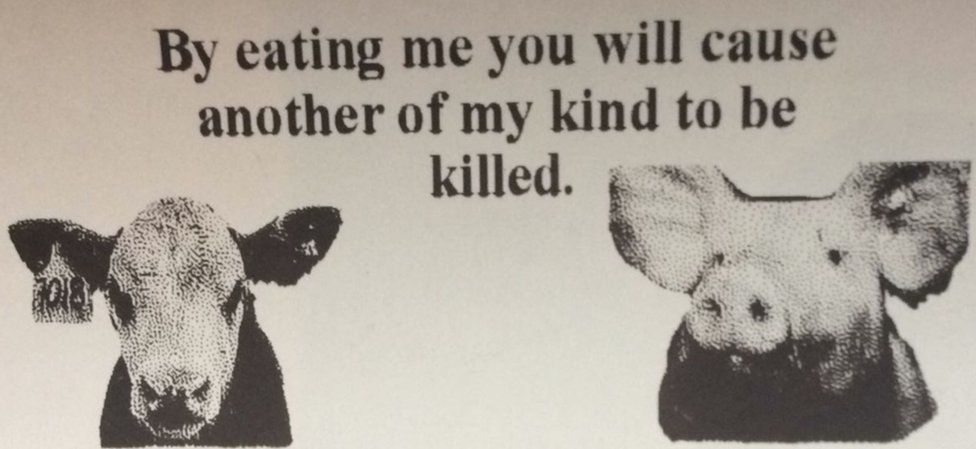
a sticker
Image caption Marc says stickers like this will make people think
We also put it to him that his stickers shocked and upset the woman in Leeds who saw a similar one on her microwave meal.
"They are peaceful and none graphic," the activist told Newsbeat.
She needs to consider what the cow was going through
Marc Gurney
"They are sending out a provocative message for people to make the connection.
"We have to be a voice for these animals for the obvious reason.
"Times are changing and there are a hell of a lot of vegan products that are a replacement for animal products."
The issue has divided opinions on social media and not everyone is sympathetic to the stickers and the people putting them on meat products.

spag bol on a plate
A customer says she was shocked and felt "emotionally blackmailed" after finding an anti-meat sticker on a packet of spaghetti bolognaise.
Leah Mallett bought the ready meal at a Morrisons supermarket in Leeds.
Marc Gurney, who runs a vegan campaign in Brighton, says he wants people to think about what they're eating.
"I think it's important that people understand that it's not right for an animal to be killed when there are so many alternatives to animal products."
He's told Newsbeat that it's also important people think about what animals go through in the food industry.
"If this girl was horrified and scared then perhaps she needs to think twice about what she puts on her plate," he says.
"She needs to consider what the cow was going through while it was experiencing a brutal torture."

cow in field
Image caption This is not the cow used on the stickers, the bovine on the campaign looks far more distressed
It's understood that the case in Leeds isn't a one-off and is part of a wider campaign.
The note that got people talking shows a cow which looked distressed along with the words: "My name was Chloe. I wanted to live. Your 'personal choice' killed me. DON'T BUY IT."
The news has been shared by Vegan Twitter accounts.
click here to follow on twiter
MORE STORIES
US psychologists claim social media 'increases loneliness'
South Korea's new President Moon Jae-in has been sworn in, vowing to address the economy and relations with the North in his first speech as president.
Everyone wants to run for US president in 2020
One customer who picked up a meal with the message on the inner sleeve told several news websites that it made her feel "horrible".
We put it to activist Marc Gurney that what he was doing was breaking the law.
"The stickers are usually placed on the side of the package," he told us. "You stick at your own risk.

Marc Gurney
"The point is we are being bombarded with images of dead animal flesh and what we are doing is raising consciousness.
"I'm not sure about the legal side but the worst that may happen is they throw you out of the supermarket."

a sticker
Image caption Marc says stickers like this will make people think
We also put it to him that his stickers shocked and upset the woman in Leeds who saw a similar one on her microwave meal.
"They are peaceful and none graphic," the activist told Newsbeat.
She needs to consider what the cow was going through
Marc Gurney
"They are sending out a provocative message for people to make the connection.
"We have to be a voice for these animals for the obvious reason.
"Times are changing and there are a hell of a lot of vegan products that are a replacement for animal products."
The issue has divided opinions on social media and not everyone is sympathetic to the stickers and the people putting them on meat products.
Summary of yesterday matches
- Yesterday: Manchester United 1-1 Celta Vigo (2-1 on aggregate, United qualify for Europa League final)
- Premier League news conferences. Next - Tottenham, Sunderland
- Harry Redknapp to remain as Birmingham City manager for 2017-18
- Stoke keen to sell record signing Giannelli Imbula
- Tonight: Everton v Watford (19:45 BST), West Brom v Chelsea (20:00); Chelsea will become champions if they win
- Get involved: Your sporting nightmares or when you refused to give up #bbcsportsday
Huge otter fossil, millions of years old, discovered in China
Huge otter fossil, millions of years old, discovered in China

Artist impression of the giant otter
The fossil of an otter as big as a wolf has been discovered by scientists in south-west China.
It's thought it roamed around the warm, humid wetlands more than six million years ago.
Named Siamogale melilutra, the huge otter would have weighed around 110lb (50kg) and been up to two metres in length.
That's far bigger than even the largest otters alive today, researchers said.
The South American giant river otter for example weighs up to about 70lb (32 kg).
"Siamogale melilutra reminds us, I think, of the diversity of life in the past and how many more questions there are still to answer," said Denise Su, Cleveland Museum of Natural History curator of paleobotany and paleoecology.
"Who would have imagined a wolf-size otter?"
The earliest known otter lived about 18 million years ago.
Fossils are rare and scattered across the globe, making the study of otter evolution more challenging.
This fossil suggests the otter would have had strong jaws an enlarged cheek teeth.
Who would have imagined a wolf-size otter?
Denise Su
Cleveland Museum of Natural History
"I think it used its powerful jaws to crush hard clams for food, somewhat like modern sea otters, although the latter use stone tools to smash shells," said Xiaoming Wang, head of vertebrate paleontology at the Natural History Museum of Los Angeles County.
"If Siamogale melilutra was not smart enough to figure out tools, perhaps the only option left was to develop more powerful jaws by increasing body size."
The fossils were found in China's Yunnan Province.
An almost complete cranium and lower jaw, teeth and limb bones were among the finds.
Although the skill had long been crushed during the fossilisation process, experts were able to reconstruct it digitally.
It revealed the animal had otter-like and badger-like qualities.
The same region has yielded a variety of other fossils, including an important ape skull, along with elephants, beavers, deer, crocodiles, swans and ducks.
click here to follow us on facebook

Artist impression of the giant otter
The fossil of an otter as big as a wolf has been discovered by scientists in south-west China.
It's thought it roamed around the warm, humid wetlands more than six million years ago.
Named Siamogale melilutra, the huge otter would have weighed around 110lb (50kg) and been up to two metres in length.
That's far bigger than even the largest otters alive today, researchers said.
The South American giant river otter for example weighs up to about 70lb (32 kg).
MORE STORIES
What is it about Glastonbury's location which makes it so muddy?
Prince William's 'touching' letter when my navy dad died
Top 10 Cancer Causing Foods to Cut Your Cancer Risk in Half

"Siamogale melilutra reminds us, I think, of the diversity of life in the past and how many more questions there are still to answer," said Denise Su, Cleveland Museum of Natural History curator of paleobotany and paleoecology.
"Who would have imagined a wolf-size otter?"
The earliest known otter lived about 18 million years ago.
Fossils are rare and scattered across the globe, making the study of otter evolution more challenging.
This fossil suggests the otter would have had strong jaws an enlarged cheek teeth.
Who would have imagined a wolf-size otter?
Denise Su
Cleveland Museum of Natural History
"I think it used its powerful jaws to crush hard clams for food, somewhat like modern sea otters, although the latter use stone tools to smash shells," said Xiaoming Wang, head of vertebrate paleontology at the Natural History Museum of Los Angeles County.
"If Siamogale melilutra was not smart enough to figure out tools, perhaps the only option left was to develop more powerful jaws by increasing body size."
The fossils were found in China's Yunnan Province.
An almost complete cranium and lower jaw, teeth and limb bones were among the finds.
Although the skill had long been crushed during the fossilisation process, experts were able to reconstruct it digitally.
It revealed the animal had otter-like and badger-like qualities.
The same region has yielded a variety of other fossils, including an important ape skull, along with elephants, beavers, deer, crocodiles, swans and ducks.
click here to follow us on facebook
Subscribe to:
Comments (Atom)




